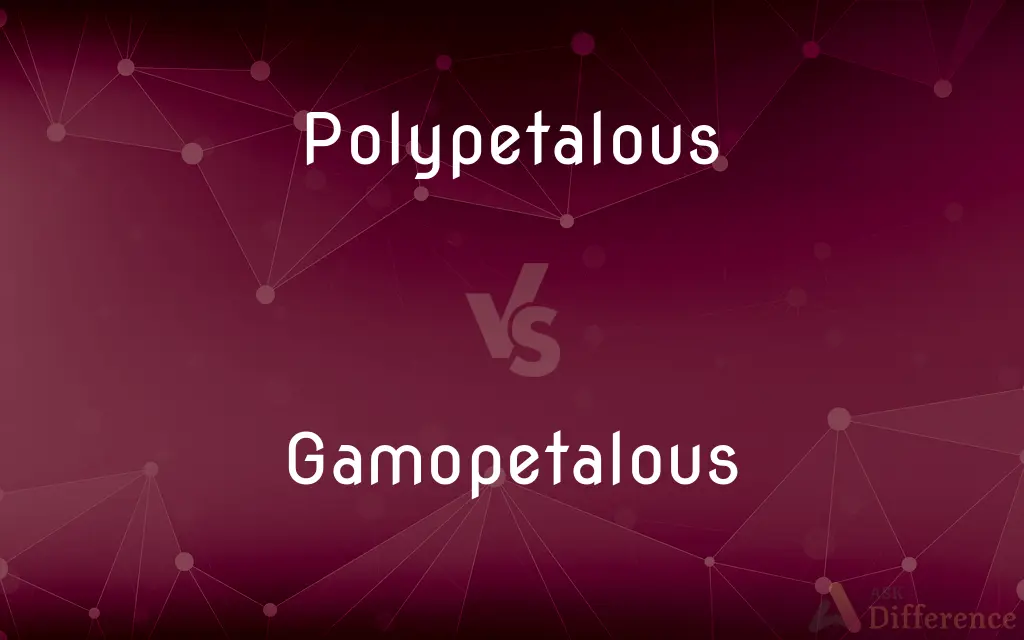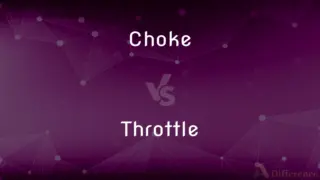Polypetalous vs. Gamopetalous — What's the Difference?
By Tayyaba Rehman — Updated on October 20, 2023
"Polypetalous" describes flowers with distinct, separate petals, while "Gamopetalous" refers to flowers with petals fused together.

Difference Between Polypetalous and Gamopetalous
Table of Contents
ADVERTISEMENT
Key Differences
Polypetalous flowers are characterized by having multiple, distinct petals that are not connected to each other. On the other hand, Gamopetalous flowers are those where the petals are united or fused together, at least at the base, forming a tube or bell shape.
The term Polypetalous is derived from the Greek words "poly" meaning many and "petalon" meaning petal, essentially denoting "many petals." In contrast, Gamopetalous originates from the Greek words "gamos" which means marriage or union and "petalon" meaning petal, signifying the "united petals."
When observing flowers, a Polypetalous structure is indicative of separate petals that can be individually plucked or identified. A Gamopetalous structure suggests a more unified appearance where the petals are coalesced, making it challenging to distinguish them separately.
In botanical classification, Polypetalous and Gamopetalous are essential terms as they help differentiate between various plant families and genera based on floral characteristics. Their presence or absence and the degree to which petals are fused in Gamopetalous flowers can offer clues about evolutionary relationships and adaptations.
Both Polypetalous and Gamopetalous terms are specifically associated with the corolla of the flower. While Polypetalous indicates more traditional or primitive floral structures, Gamopetalous structures are often seen in more specialized or evolved flowers, aiding in specific pollination strategies.
ADVERTISEMENT
Comparison Chart
Petals Structure
Separate petals
Fused or united petals
Origin of Term
Greek: "poly" (many) + "petalon" (petal)
Greek: "gamos" (union) + "petalon" (petal)
Appearance
Individual, distinct petals
Unified tube or bell-shaped corolla
Evolutionary Aspect
More traditional/primitive
More specialized/evolved
Use in Classification
Differentiates plant families/genus
Indicates specific pollination strategies
Compare with Definitions
Polypetalous
Referring to flowers with distinct and separate petals.
Roses are polypetalous flowers with many individual petals.
Gamopetalous
Describing flowers with petals fused or united together.
The morning glory is a gamopetalous flower with a tube-like shape.
Polypetalous
Pertaining to plants with flowers having individual petals.
Many wildflowers exhibit a polypetalous structure.
Gamopetalous
A botanical term indicating united petals in flowers.
The gamopetalous characteristic of the bloom aids in its pollination strategy.
Polypetalous
Descriptive of flowers showcasing many petals not attached to one another.
The artist preferred painting polypetalous blooms due to their intricate patterns.
Gamopetalous
Relating to plants with petals joined, at least at the base.
Many tropical flowers have a gamopetalous structure.
Polypetalous
A floral characteristic indicating non-fused petals.
The polypetalous nature of the blossom made it easy to pluck each petal.
Gamopetalous
Having a corolla with petals that are not distinct from each other.
The campanula flower is gamopetalous, with petals forming a bell shape.
Polypetalous
Not having united petals in a floral structure.
Daisies are a common example of polypetalous flowers.
Gamopetalous
Characteristic of flowers showcasing a single, unified petal structure.
The gamopetalous trait is predominant in many ornamental plants.
Polypetalous
Having separate petals, as in the corolla of a rose or carnation.
Gamopetalous
Having or designating a corolla with partially or wholly united petals.
Polypetalous
(botany) having a corolla composed of distinct, separable petals
Gamopetalous
(botany) Having petals wholly or partially fused in such a way that the corolla takes the form of a tube, trumpet, channel, or similarly nearly-rigid structure.
Polypetalous
Consisting of, or having, several or many separate petals; as, a polypetalous corolla, flower, or plant.
Gamopetalous
Having the petals united or joined so as to form a tube or cup; monopetalous.
Polypetalous
Having a corolla composed of many separated or distinct petals
Gamopetalous
Having a corolla composed of partially or wholly fused petals forming a corolla shaped like a tube or funnel
Common Curiosities
How is Gamopetalous different from Polypetalous?
Gamopetalous describes flowers with petals fused or united together.
Why are these terms important in botany?
They help in the classification of plants and understanding evolutionary relationships.
Are roses Polypetalous or Gamopetalous?
Roses are polypetalous with separate petals.
Which term indicates a more evolved flower structure?
Gamopetalous structures are often seen in more specialized or evolved flowers.
Which flowers commonly display a Gamopetalous structure?
Flowers like morning glory and bellflowers are gamopetalous.
What does Polypetalous mean?
Polypetalous refers to flowers with distinct, separate petals.
Are all modern flowers Gamopetalous?
No, many modern flowers are still polypetalous.
Is a tulip Polypetalous or Gamopetalous?
Tulips are generally considered gamopetalous as their petals are largely fused.
Do these terms apply to plants worldwide?
Yes, they are universal botanical terms used in plant classification globally.
Can a flower be partially Gamopetalous?
Yes, some flowers have petals fused only at the base, making them partially gamopetalous.
Do Polypetalous flowers have an evolutionary advantage?
Both types have their advantages; polypetalous might indicate broader pollinator appeal.
Why might flowers evolve a Gamopetalous structure?
To aid in specific pollination mechanisms or to adapt to environmental conditions.
Is the term Polypetalous common in floral identification?
Yes, it's a fundamental botanical descriptor for floral structures.
What is the significance of a Gamopetalous structure in pollination?
The fused petals can aid in specific pollination strategies by directing pollinators.
How are the terms derived?
Both terms come from Greek, with "petalon" meaning petal, "poly" meaning many, and "gamos" meaning union.
Share Your Discovery

Previous Comparison
Checkbook vs. Chequebook
Next Comparison
Choke vs. ThrottleAuthor Spotlight
Written by
Tayyaba RehmanTayyaba Rehman is a distinguished writer, currently serving as a primary contributor to askdifference.com. As a researcher in semantics and etymology, Tayyaba's passion for the complexity of languages and their distinctions has found a perfect home on the platform. Tayyaba delves into the intricacies of language, distinguishing between commonly confused words and phrases, thereby providing clarity for readers worldwide.
















































